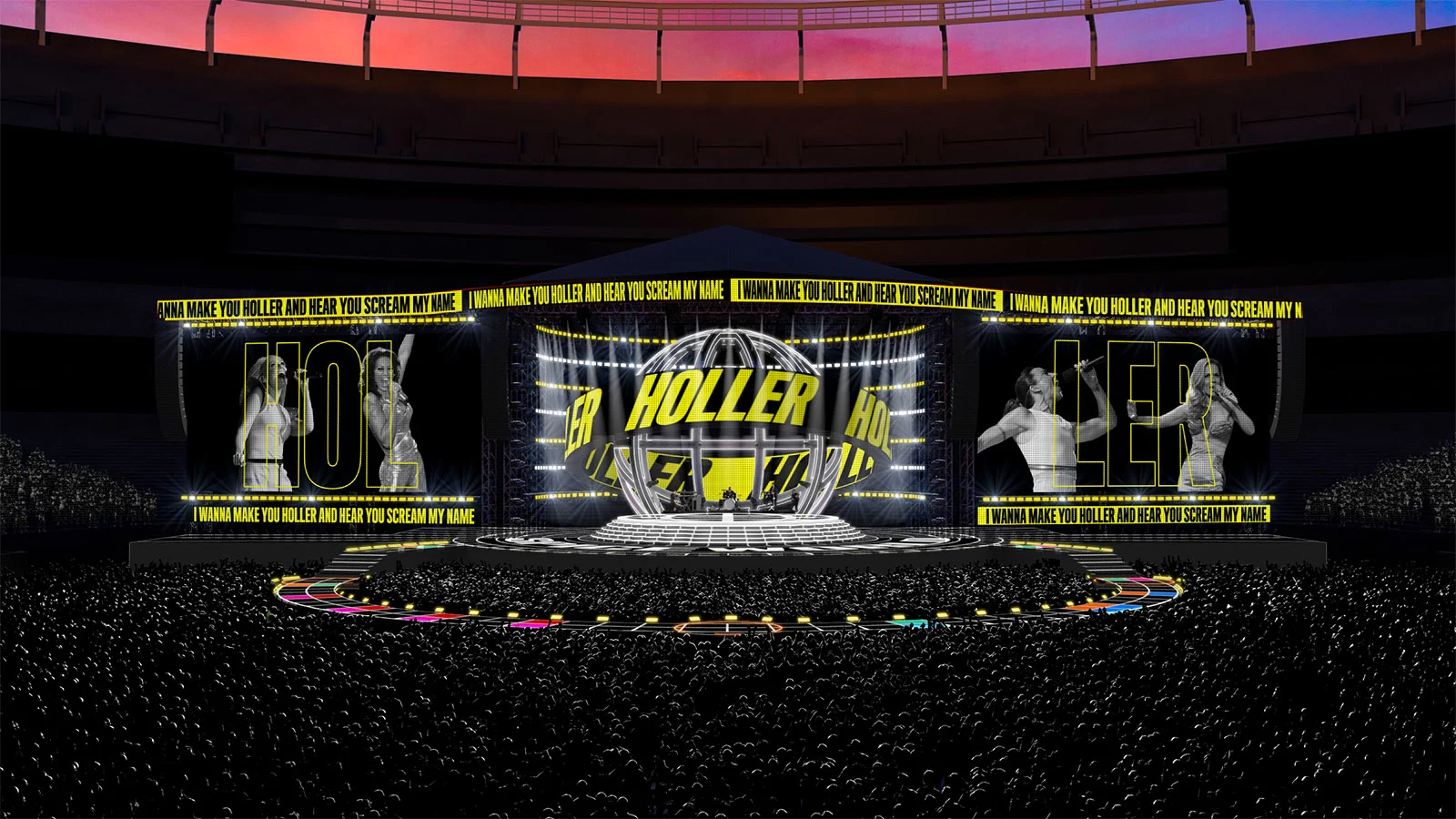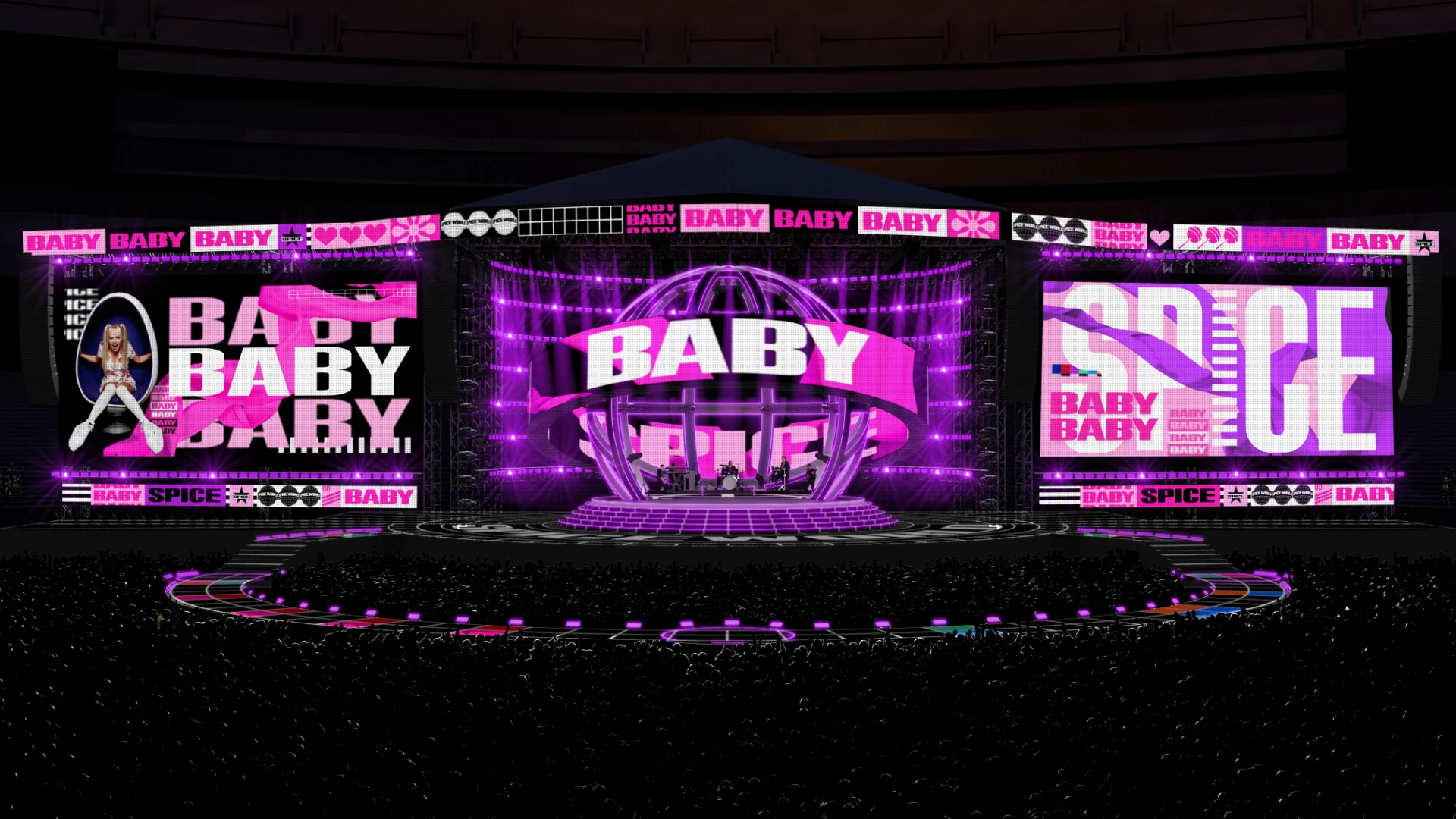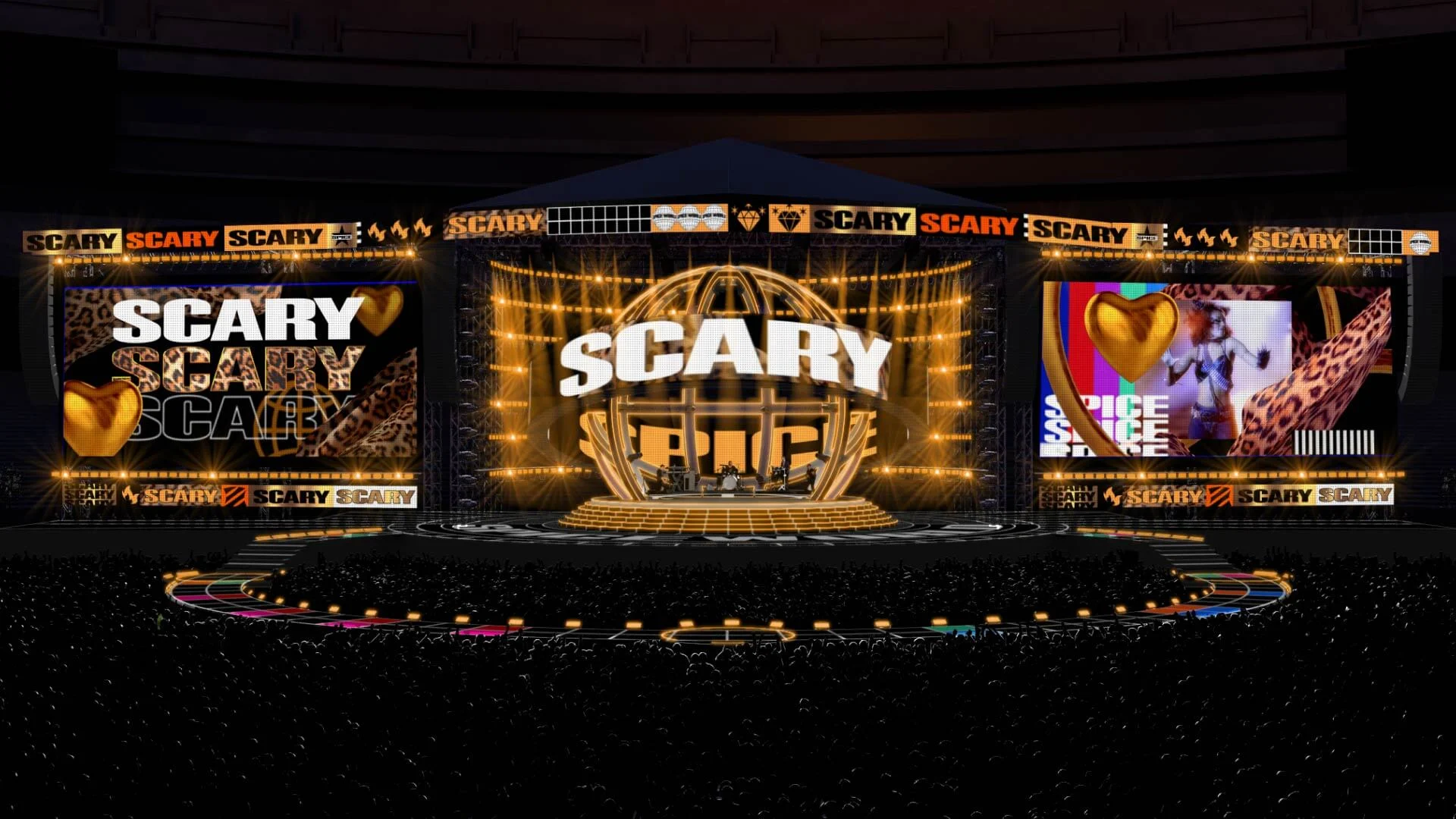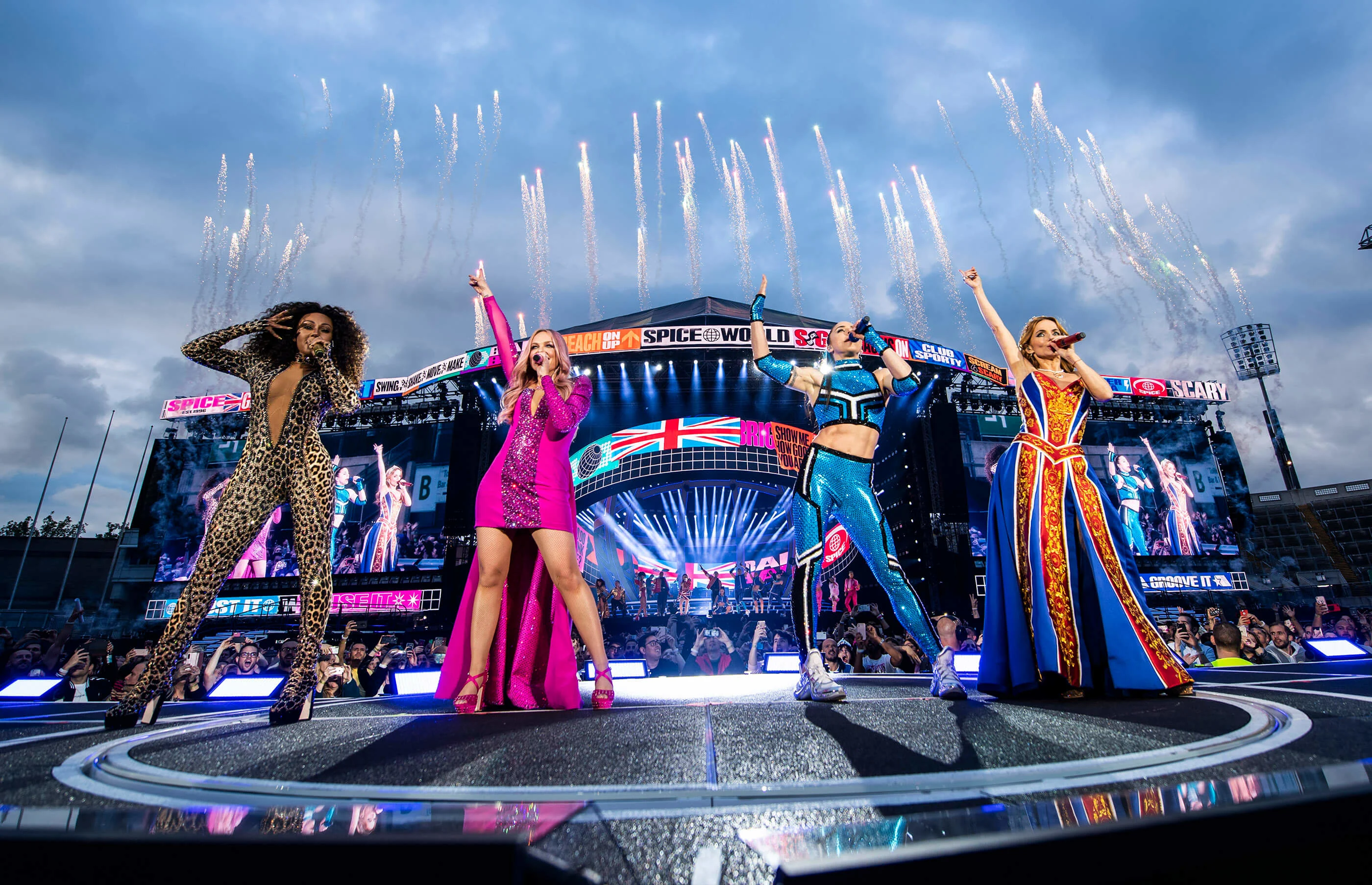
A quarter century after the group first emerged, a dozens-strong creative team have brought the aesthetic of the most iconic musicians of the 1990s hurtling into 2019. Douglas Greenwood meets costume designer Gabi Slade and art director Aries Moross to tell us how they did it.
Photography by Andrew Timms.
Saturday night at London’s Wembley Stadium. The pitch lights dim and marching band music plays, as a procession of dancers strut across a lengthy catwalk that crescents the stage. Each is dressed in a candy pink outfit, sleek blue sports gear, leopard print or Union Jack-emblazoned regalia, flanked by screens flashing malfunctioning TV chess patterns and messages of unity. “We welcome all ages… races… gender identities … sexual orientations,” they read.
A gigantic LED ring slots over a meridian globe: a pop culture symbol modernised. The drum beats halt and pyrotechnics fly: four women – Baby, Sporty, Scary and Ginger – emerge to the screams of 80,000 people. This is the Spice Girls, reinvented for a new era.

Almost 25 years after these women (plus Victoria ‘Posh’ Beckham, absent here citing work commitments) marched into the office of Virgin Records and altered the course of pop culture forever, the Spice Girls once again have the world at their feet. It’s 2019, and a decade after their last worldwide tour wrapped, the quintet has since become four, but have reunited regardless for a run of sold-out stadium shows.
The tour, named ‘Spice World’ after their cult 1997 film and sophomore record, coincides nicely with culture’s undying infatuation with the nineties right now. For the past half decade, teenage girls have been pestering their mothers and older sisters to fish out chunky Buffalo shoes and crop tops (now a staple on every high fashion runway) from the back of their wardrobes. Meanwhile, the public’s fascination with neon colors, vintage Keanu Reeves flicks and polaroid cameras is at an all time high. Commercially speaking, what better time for the era’s most iconic pop band to ride the wave?
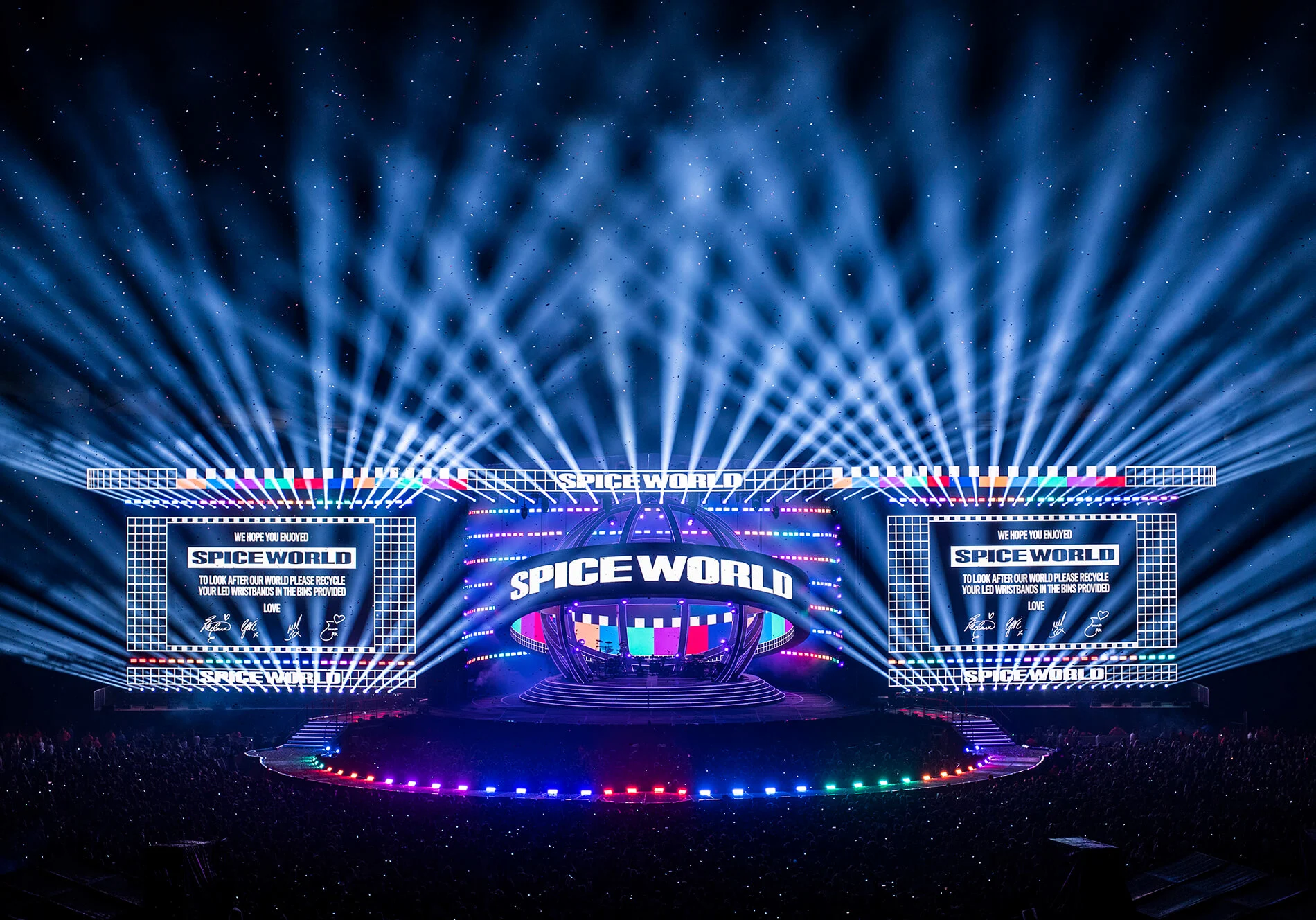
It was in November last year that a team – comprised of creative director Lee Lodge, art director Aries Moross, costume designer Gabi Slade and production designer Jason Sherwood – pitched their vision of a new Spice World to the girls. Since then, their respective groups have been working full time to pull the multi-million pound production together. Despite the wealth of references at their disposal, the team were aware from the beginning that they couldn’t propose a simple, pandering trip down memory lane. “The term I’ve used to describe it is ‘2019 through a nostalgic lens’,” Gabi tells me.
So how do you form a show that excites both the Spice Girls and 700,000 of their followers expecting to relive the girl power fantasy of their youth? The starting point was simple: the team in charge had to be fans themselves. “Personally. I don’t think a non-fan would have wanted to work on this project,” Aries, whose company Studio Moross headed up the branding and art direction for the show says. “If there’s ever a project to sit in front of an artist with and say, ‘I’m a huge fan’, this is it. It helped understand how sacred the legacy of the Spice Girls is.”

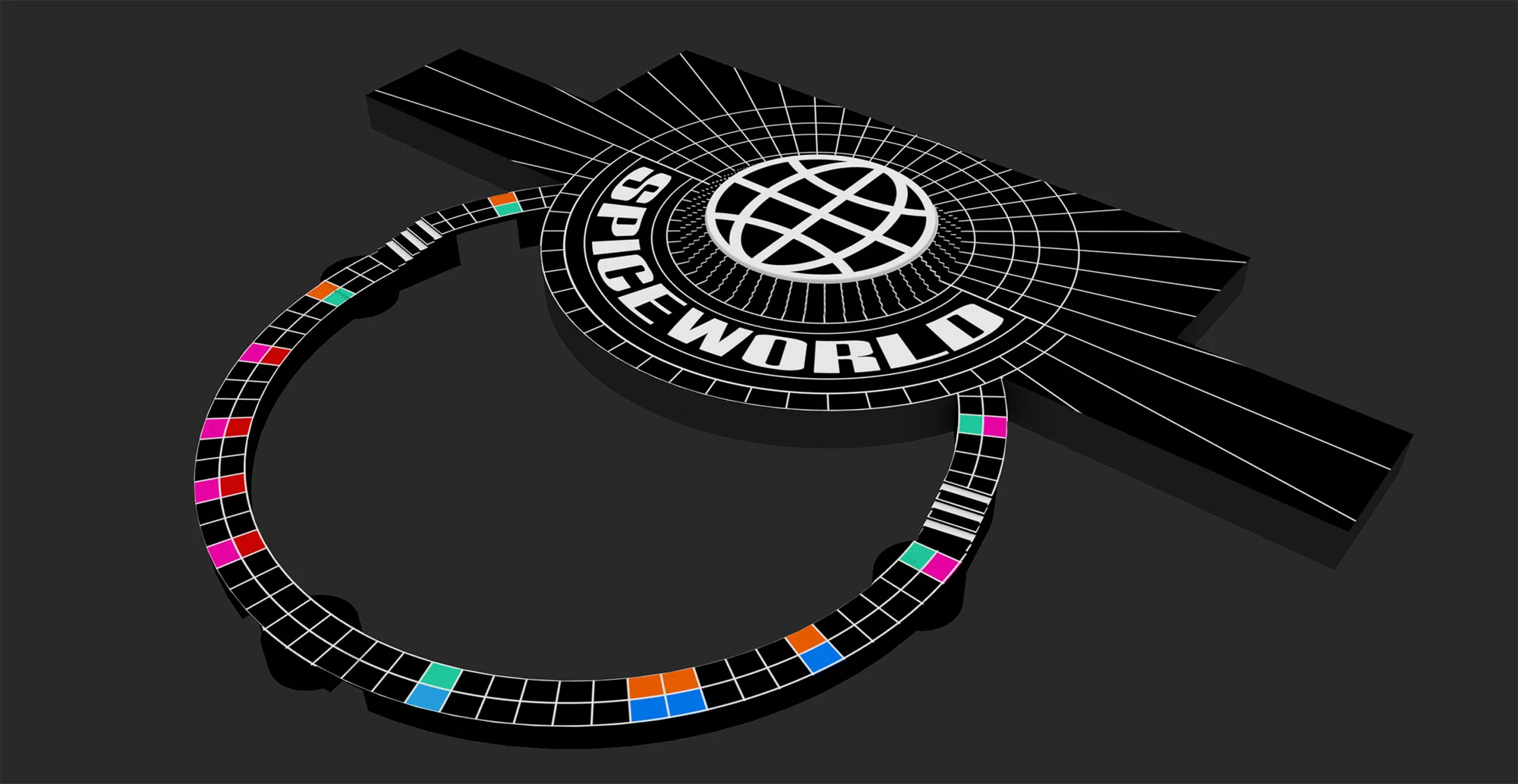


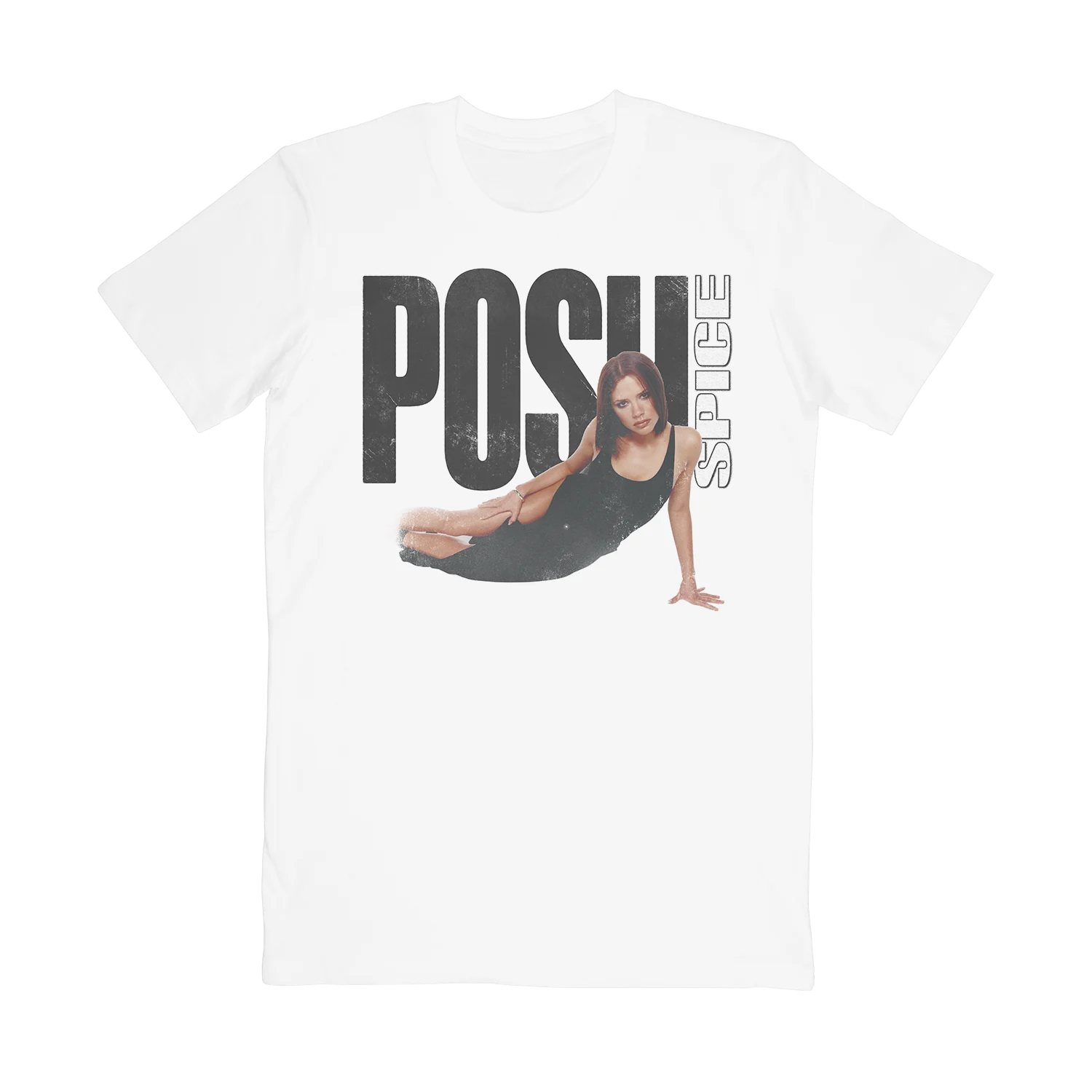

Over the course of the effervescent 100-minute production, that respect for Girl Power and the DNA of the band is proudly at the forefront, but there was a desire from all sides to modernise it, to reflect the current social climate. The new version, as Geri ‘Ginger’ Horner stated late last year, champions “people power” instead.
That stance is a key element of the on-screen visuals and merchandise created by Studio Moross. The global message of feminism once preached by the group is wider, including, as the build-up to the first act states, people of all gender identities, sexualities, abilities, races and backgrounds. “I was very forthcoming with my identity as a queer trans person and my feelings about inclusivity, ensuring we don’t think of the Spice audience as mums and gay men,” Aries claims, “because it’s a much bigger world now. We tend to distill things down to the loudest voices, but we need to make sure that everyone feels like they can come here and not feel alienated by the movement.”
It’s a natural progression that might have felt out of place at a stadium show, if not for the fact that Aries themself is queer, alongside many others in the creative team. The Spice Girls, too, are famed for propelling ostracised movements into the mainstream. “It’s a very big platform to shine a light on,” Aries adds. A t-shirt from the tour’s line-up features the phrase ‘G*rl Power’: the asterisks a sign of solidarity to trans and non-binary Spice fans. “I think everyone feels like all approaches to feminism should be inclusive and intersectional,” they say of the quietly revolutionary t-shirt. “I don’t know if ‘GIRL POWER’ is a simplified expression of that feeling, but we wanted to show that, in its simplicity, it also has a lot of power.”
Each of the girls are, throughout the night, flanked by their own ‘house’ of dancers: a nod to the voguing scene of the mid-20th century in New York’s queer spaces. When creating the visuals, Aries formed the house aesthetic by pairing colour-coded pop art graphics for each girl with excerpts from the band’s videos that festoon and frame the stage. It does, at times, feel like a industrial Berlin rave as much as a stadium pop show. That queer referencing filtered into the choreography and costuming too, with Gabi Slade's designs toeing the line between cutting edge and camp.
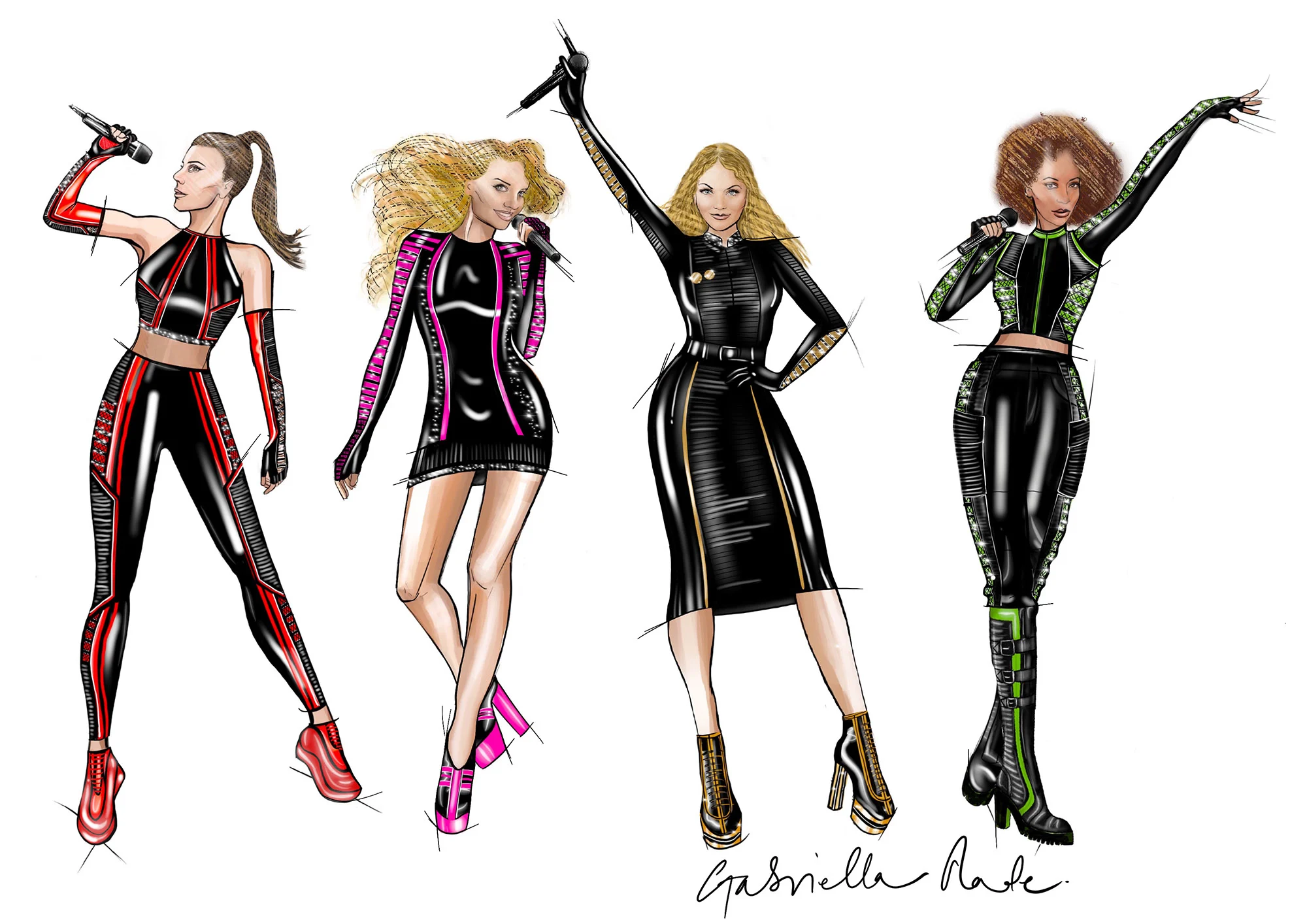

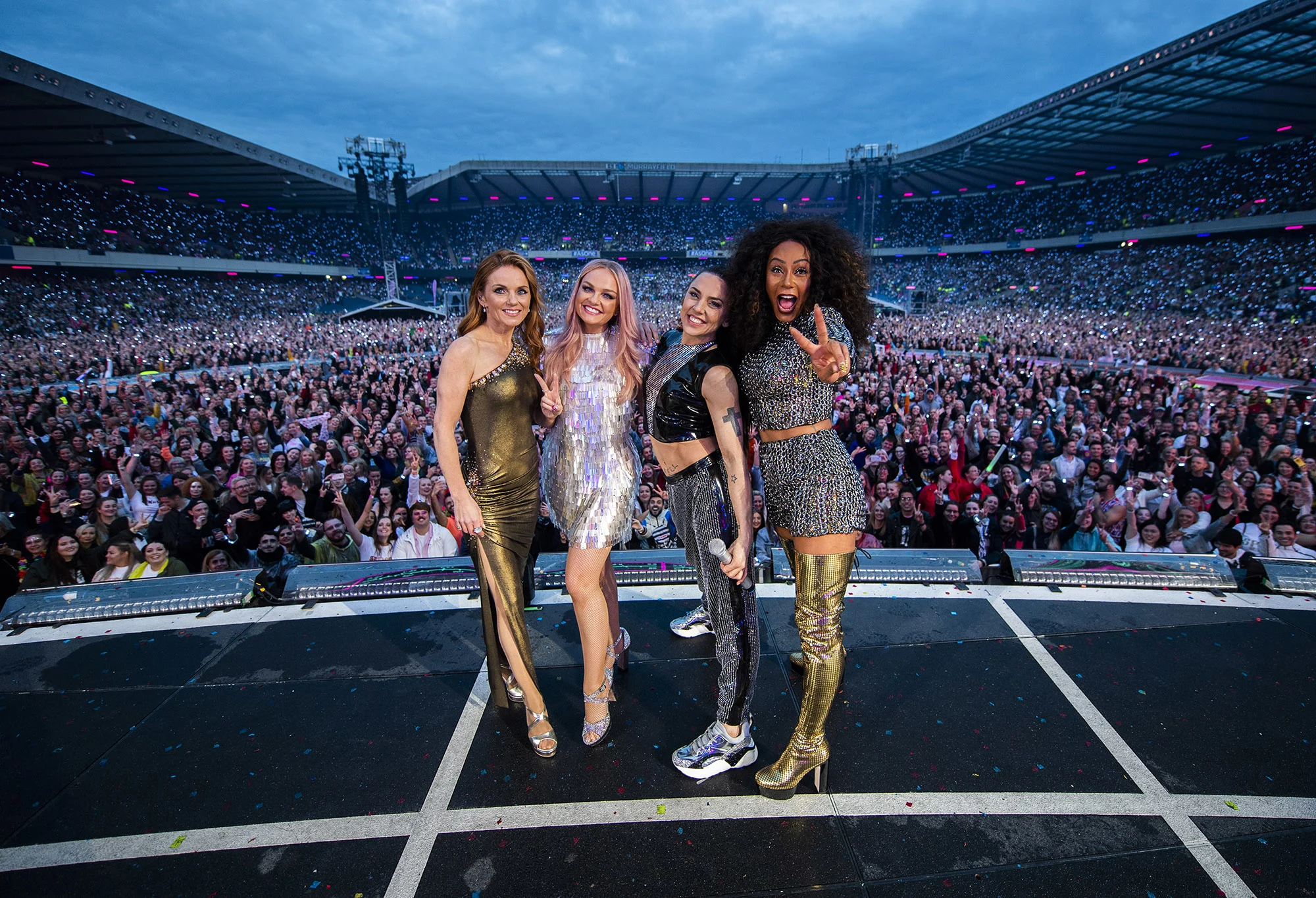
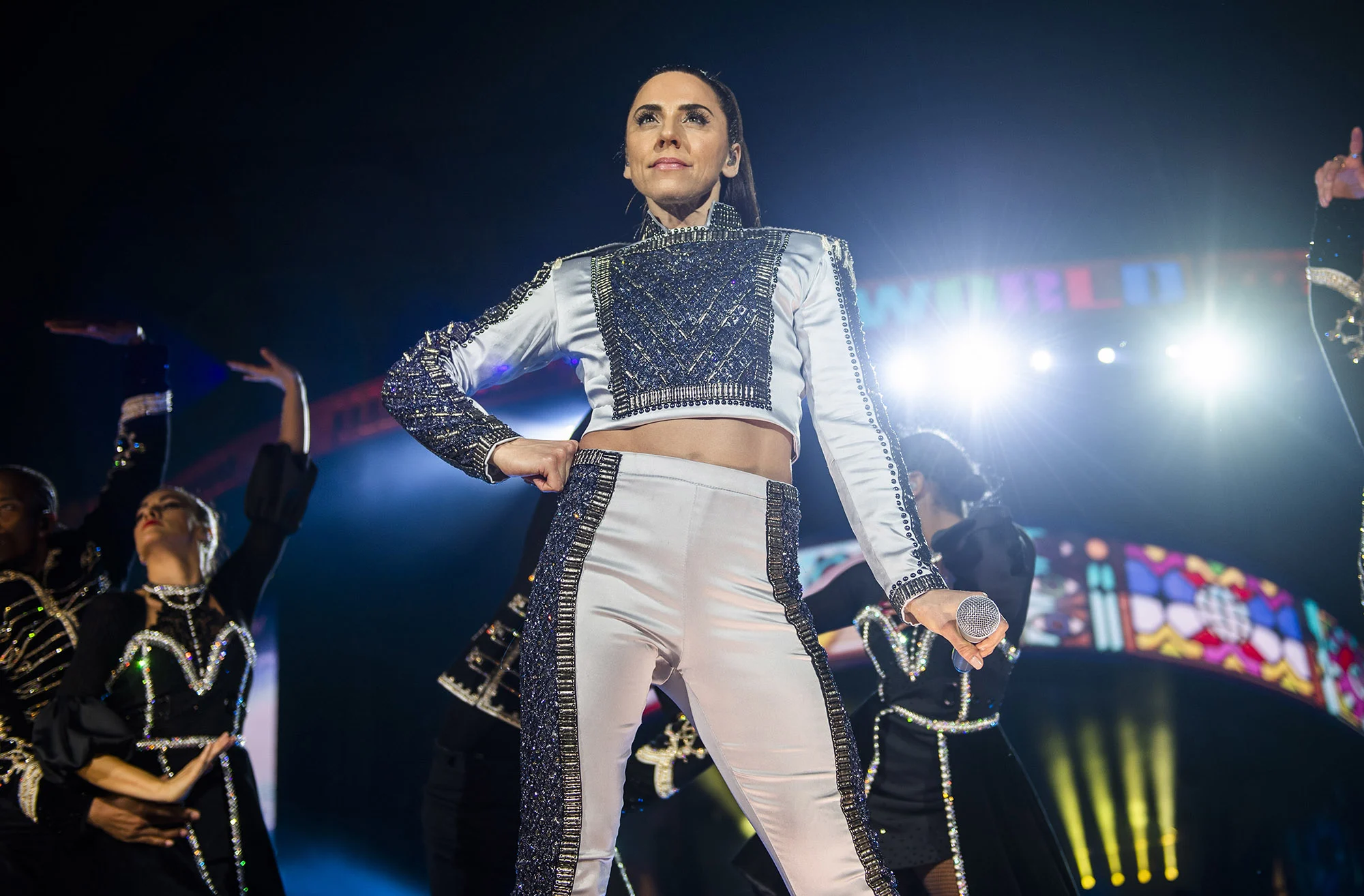
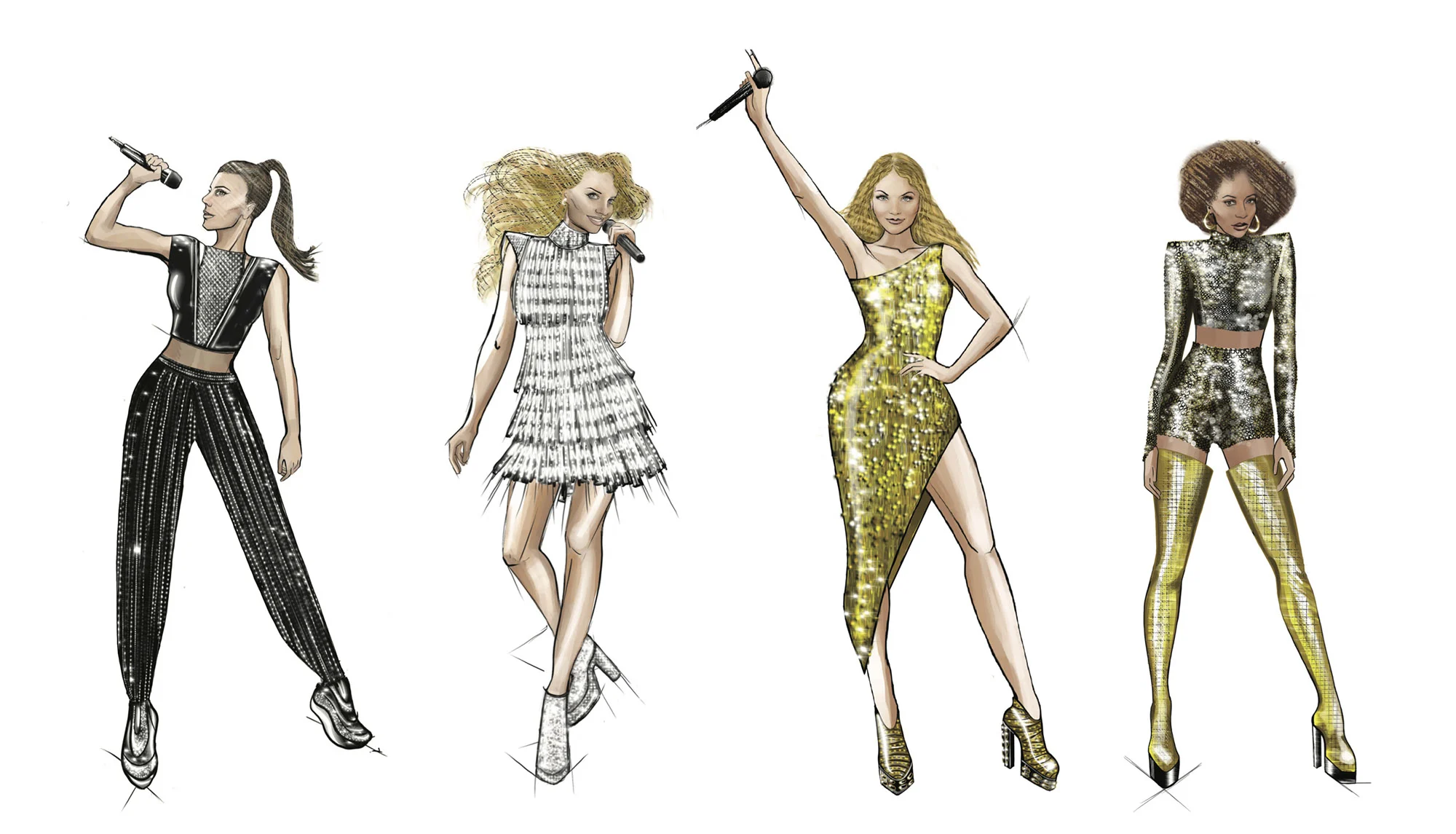
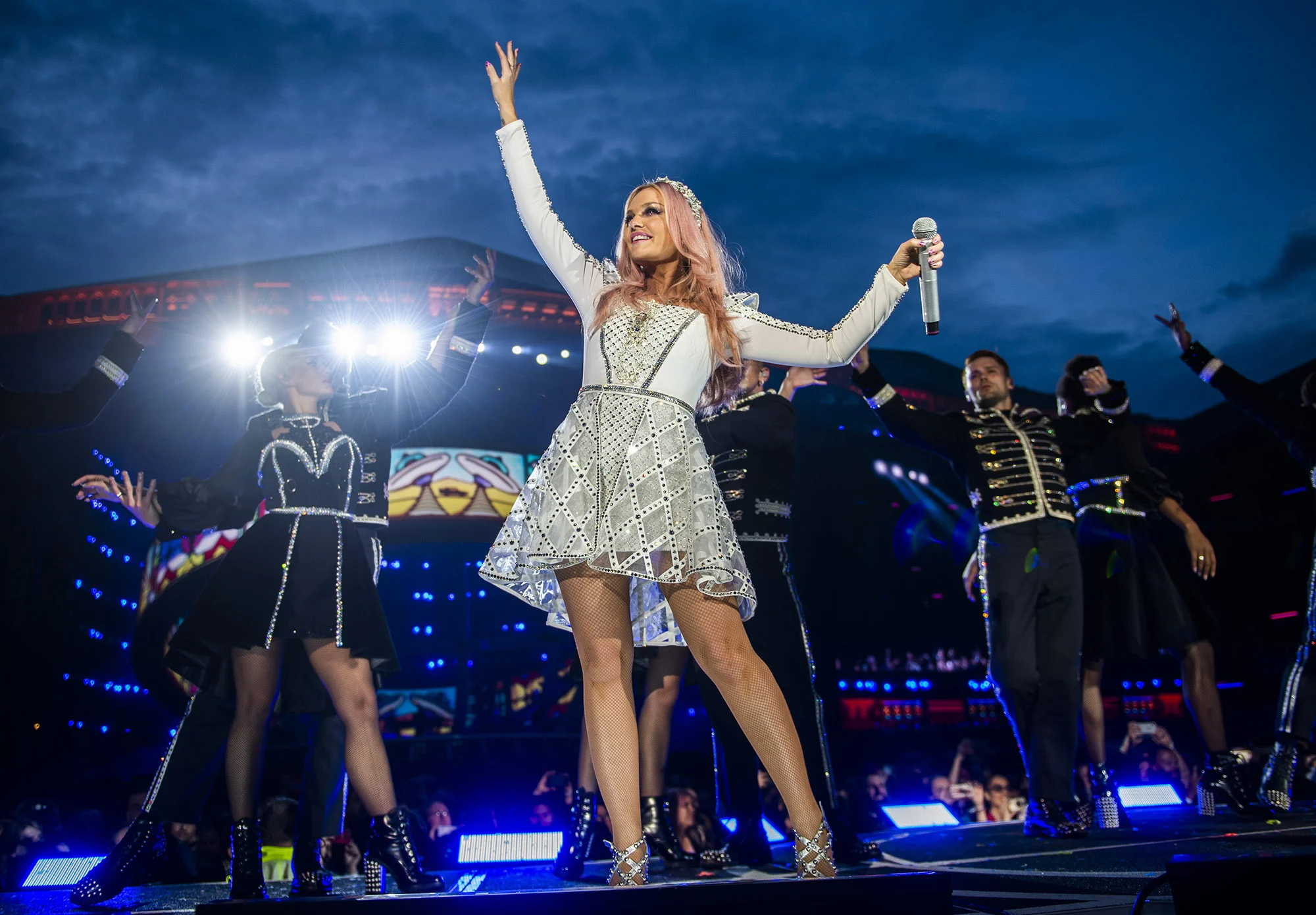
At the height of their fame, the Spice Girls formed outfits that acted as markers of the band’s identity. Their wardrobes were the kind teenage fans could replicate with the help of high street stores: those aforementioned Buffalo shoes, tracksuits and cami tops were widely seen as a uniform for the band’s admirers.
That formative impact on 90s fashion is something Gabi hasn’t forgotten about; in fact, it was at the forefront of her mind when it came to creating the garments for Spice World. After the creative team had cemented the aesthetic for each ‘act’ of the show, Gabi got to work. “I started moodboarding images, looking at what the girls wore in the 90s and early 00s,” she says, “and then now. I was trying to fuse those two together.”
The hallmarks remain the same. Geri opens the show in a regal, floor length gown with the Union Jack embroidered with gold accents, reminiscent of her iconic look from the 1997 Brit Awards. Mel B, on the other hand, wears a full-body leopard print catsuit, hand studded with hundreds of Swarovski crystals. “It looks fabulous,” Gabi quips, “but I think we spent a good week to ten days on that garment” – the most time-consuming piece in the show’s line-up.

It was a constant battle with the concept of elevation, Gabi says, to bring these garments to life. "We didn’t have a shortlist of four looks we wanted to replicate – it was never as literal as that," she explains. "Instead it was far more fluid. For me, it was a sense of taking what they had worn and saying ‘Okay, we want to do this but do it for now'." She had to select the fabrics that would help move the girl's wardrobe forward, instead of harnessing it to the past. "All of those elements were part of the process.”
This meeting of two eras is a concept she’s familiar with, having worked on the theatre musical ‘Six’, in which the former wives of Henry VIII are transformed into current day popstars through costume (think Little Mix if they were about in the Tudor times). She was nominated for an Olivier for her work.
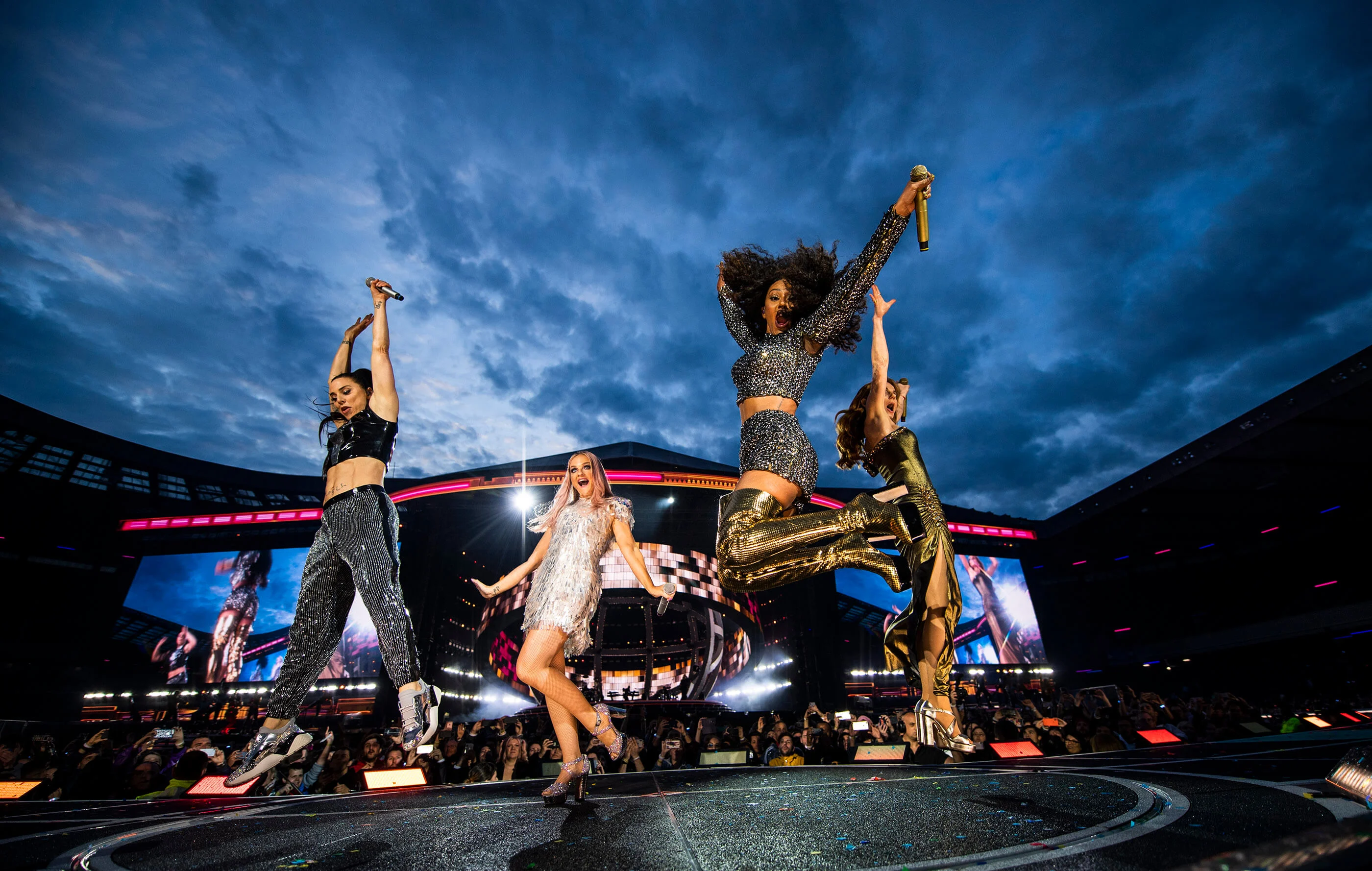
Perhaps the most clear example of how she channeled the 'grown up' Spice Girls comes in the show's so-called ‘Disco Act’. The silhouettes will be familiar to die-hard fans, but the fabrics and materials are the kind the band have never worn, as a group, before now. "For me, was all about metallic colours: shine and shimmer," Gabi claims.
Emma, ever the "girly girl" of the group, wears a mini dress comprised of thousands of plastic droplets, individually stoned with swarovskis and paired with military-style epaulettes. It suits the setting – camp and extravagant – but could just as easily feel like part of Miuccia Prada’s recent runway collections. Meanwhile, Mel B wears a two piece covered in round plastic discs that reflect the lights and flashes of the crowd’s cameras; glitter thigh high boots included. "For me, they feel interesting as textiles but still pay homage to Ginger, Scary, Sporty and Baby as well," Gabi says.
Throughout the fiery live show, all of the hallmarks of the 90s most iconic pop group remain, but the era’s spirit feels more potent; more muscular. What was once technicolor vinyl is now metallic. The band's poppy visuals have become a little more glossy, with hints of daring and unrelenting club elements too.

You could forgive the creative team for choosing to stage a show that placed nostalgia in its most basic form at the forefront. That notion of "simplification," Aries says, is something the team had to reckon with while keeping the new-found ethos of the group – a contemporary one to portray to a wide audience –clear and respectful. After all, the newest song the group perform in their set, Let Love Lead the Way, was recorded in the summer of 1999. A yearning for the past, naturally, plays a pivotal part in understanding why close to a million people showed up.
In the wrong hands, nostalgia can simply be a synonym for ignorance. The past felt like bliss because we knew less, and the Spice Girls represented escapism; a chasing of something new. That the ultimate carriers of 90s pop nostalgia chose to reinvent themselves 25 years down the line is a pop culture chapter in itself.
And as for those who got to take them there? It was a childhood dream come true.


